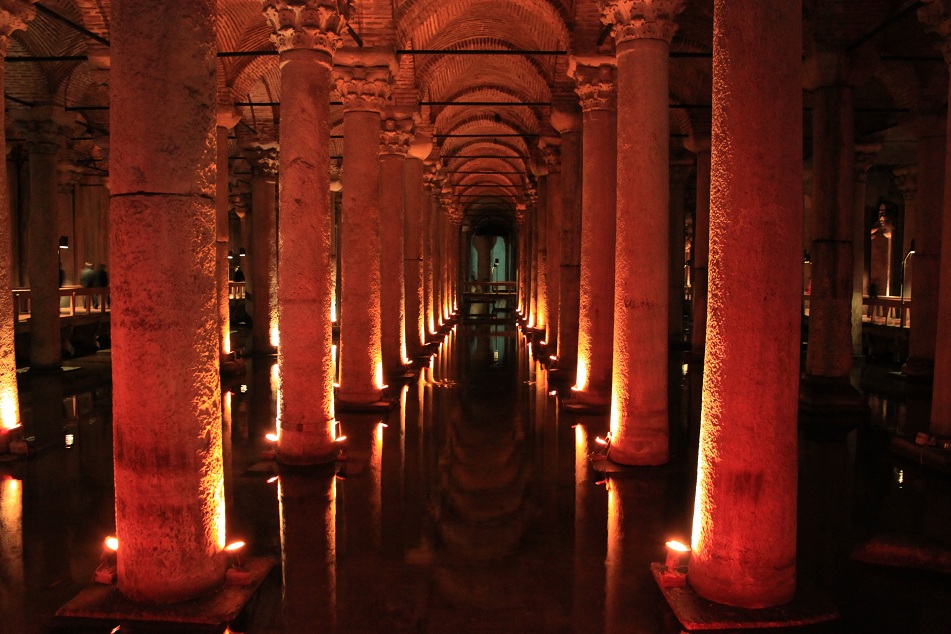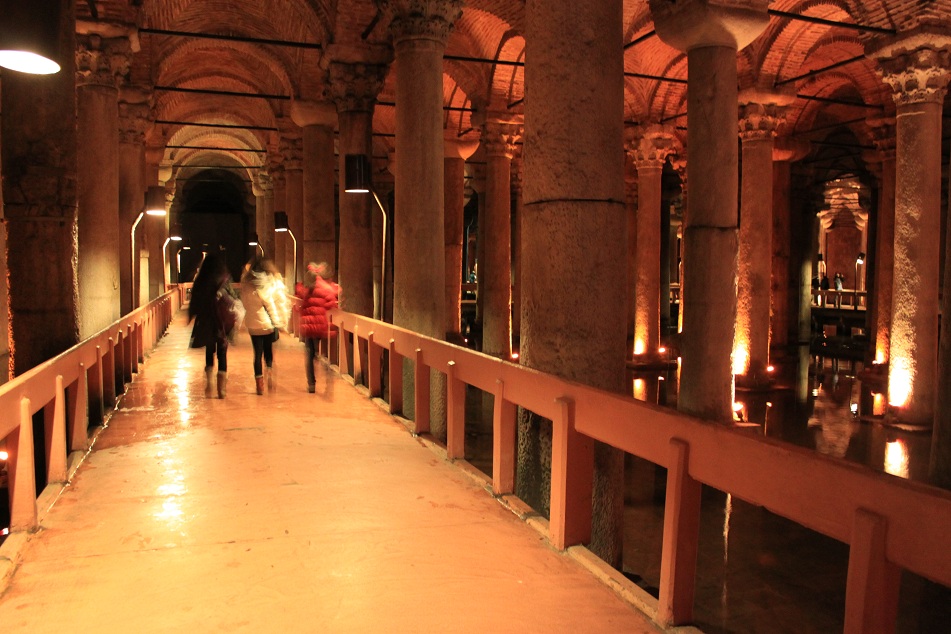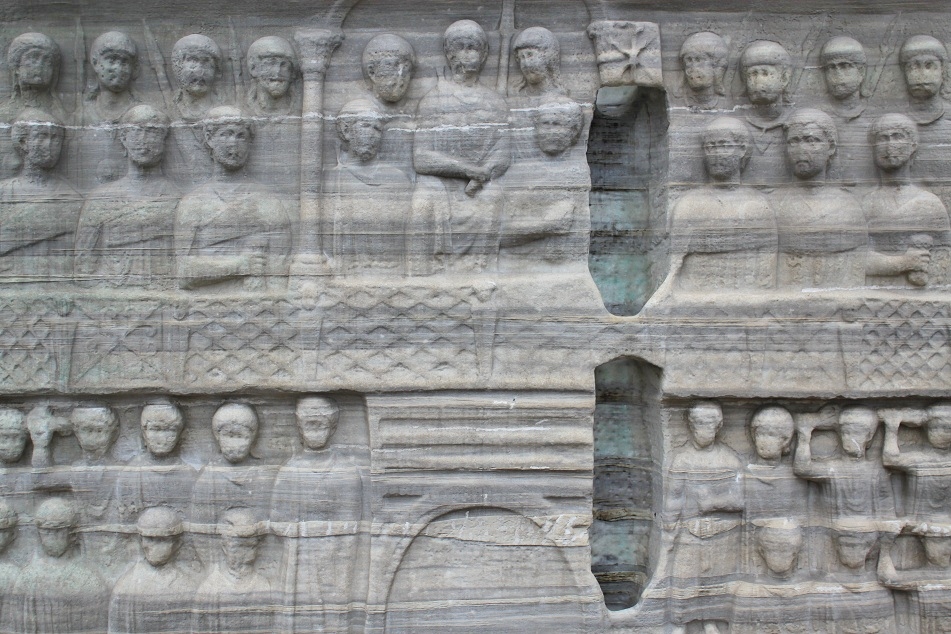The 55 stone steps take me to a vast underground opening where rows of floodlit columns are partially submerged under the clear freshwater. Grey fish – some are bigger than a cat and never see the sun – roam around the submerged columns, undisturbed by the constant flow of humans walking on the platform above. This is Basilica Cistern, built by the Romans in the 6th century AD to provide freshwater for the inhabitants of Constantinople. The old city of Constantinople was surrounded by seas – Sea of Marmara to the east and south, and the Golden Horn to the north. Hence building cisterns was necessary to ensure freshwater supply for the city.
Owing its name to the once great basilica that stood above it, Basilica Cistern is the largest of all ancient cisterns in Istanbul. The ceiling is supported by 336 columns with capitals in Ionic, Corinthian, and Doric styles. Two columns at the far end of the cistern draw people’s attention the most as they are supported by two large Medusa heads, one curiously turned upside down and the other leaning on the right side of her face.
One of the most important buildings in the old city which relied on the cistern for its freshwater supply was the Great Palace of Constantinople, which is now mostly in ruins. The Romans are known to build remarkable buildings in regions across the Mediterrannean Sea which were once in the realm of the great empire. Some structures were built out of necessity – such as the Basilica Cistern – and some others were constructed merely for entertainment. Being the seat of power of the empire since the 4th century, several typical Roman structures were built in the old city, including near the great palace itself.
One of the works commanded by Constantine the Great was the renovation of the Hippodrome in the 3rd century which were built during the reign of Emperor Septimius Severus more than a century earlier. As the name signifies, the Hippodrome was a public place where chariot races took place. Located next to the great palace, the Hippodrome was one of the few places where the emperor and the people could be spotted at the same place.
To boost the image of the new capital of the empire, Constantine and his successors brought artworks from all corners of the empire to be showcased at the Hippodrome. The Serpent Column from the Temple of Apollo (Greece) and the obelisk of Tuthmosis III from the Temple of Karnak (Egypt) were the two most prominent artworks which were brought to the Hippodrome. Throughout the time, later additions were constructed in the Hippodrome to maintain the prestige of this place, and the empire in general. Some of them barely survived the time – such as the Walled Obelisk, while some others had long completely gone.
On a cloudy day I walk down the Hippodrome, or what is left from it. The 3,500 years old Obelisk of Tuthmosis III – also referred as the Obelisk of Theodosius – is still remarkably intact, standing in front of the Walled Obelisk which was once covered in gilded bronze plaques. The dirt tracks are now covered by cobblestones, the Great Palace of Constantinople had long fallen apart, and the empire had long perished. But its traces are spread throughout the ancient world, leaving us with questions and imagination of the time when it reached its peak.








Reblogged this on AUSSYNEWZY.
LikeLike
I love your shots of the Basilica Cistern – it seems like such an evocative place! It’s amazing that the obelisk of Tuthmosis III managed to survive all these years intact. Thanks for another informative post from Istanbul. 🙂
LikeLike
Thanks James! Walking around Sultanahmet neighborhood, you wouldn’t realize there’s such place underground if they didn’t put the signboard. In fact I heard some people who visited Hagia Sophia and the Blue Mosque missed the cistern altogether because they weren’t aware it was there. Standing before the obelisk made me dream of a trip to Egypt one day! 🙂
LikeLike
Wonderful shots Bama! Brought back fond memories 🙂
LikeLike
Thanks Madhu! It’s easy to see why you had some fond memories in Istanbul. It’s such a lovely place, indeed.
LikeLike
Your writing makes me feel like I’m really there. Maybe someday I will!
LikeLike
Thanks Sarah! You’ll never know, it could be sooner than later for you to visit Istanbul!
LikeLike
beautiful and inspiring piece. The photographs are simple yet capturing of the mood.
LikeLike
Thanks for your kind words! The weather was somewhat really moody when I was there.
LikeLike
Lovely photographs, capturing some truly amazing places!
LikeLike
Thanks Sindhu! Istanbul has some of the most amazing places that I’ve ever been to.
LikeLike
Takes me back to my visit there in May. It was a bit warmer then! The cistern was amazing to walk through and I think your photos do a great job of capturing that.
LikeLike
If I had a chance to go back to Istanbul, summer would be a perfect time I guess. Thanks Hayley!
LikeLike
Not sure how long you’ll be there, or if you want/have time to meet a prolific blogger who lives in Istabul … lmk if you do (I don’t think I see her comments on your blog)
LikeLike
Oh you happen to know a blogger who’s based in Istanbul? That would be great to meet her. However unfortunately I have returned to Jakarta, so maybe next time. 🙂 Thanks by the way!
LikeLike
Great shots, Bama! The information which you provide is also complete. Thanks for sharing it here.
LikeLike
Thanks Chris! I wish the weather were better though on the day I went to the Hippodrome.
LikeLike
I was hoping your would cover the cistern! It was one of the places I found fascinating and intriguing in Istanbul. I remember the sideway face of Medusa. Thanks for bringing back fond memories of the place.
LikeLike
It definitely was! I remember walking towards the unassuming entrance of the cistern which hid the magnificent structure below. Thanks for your lovely words Marisol!
LikeLike
Wow! I like the shots and how you clearly explain every shot.
LikeLike
Thanks for your lovely comment! I always try to make the pictures bring certain feeling that I felt during my visit.
LikeLike
you are welcome.
LikeLike
Jadi inget, di film apaa gitu.. supaya nggak kebunuh oleh makhluk berkepala Medusa, kita nggak boleh memandang matanya 😀
Kamu punya akun Flickr atau Picasa atau Instagram atau sejenisnya nggak, Bam? Ingin lihat foto-foto yang lebih banyak! So far, selalu suka dengan foto-fotomu! ::thumbs
LikeLike
Kalau saya sih pertama kali tau mengenai Medusa di Saint Seiya. 🙂 Wah, gak ada akun2 di situ kecuali instagram, itupun jarang banget dipake. Sebulan sekali aja belum tentu. :p Thanks Ika!
LikeLike
Great shots. I just love Istanbul architecture so much; it’s like a lovechild between Roman’s extravagance and Muslim art’s delicate complexity. Happy to see a fellow Indonesian travel blogger too! Not much has been written about Indonesia on the web, which is quite a shame as it’s a really underrated destination, here’s to reading more coverage of it. =)
LikeLike
Hi Andrew. Thank you so much! That is one of the best descriptions of Istanbul architecture I’ve ever read so far. Well said! There are still a lot of people who know nothing about Indonesia and some even have this perception of Bali as an entirely different country. It’s one of the reasons why I started this blog: to introduce beautiful places in this sprawling archipelago.
LikeLike